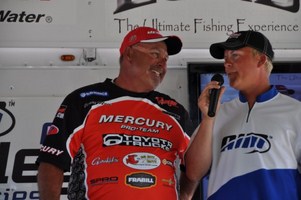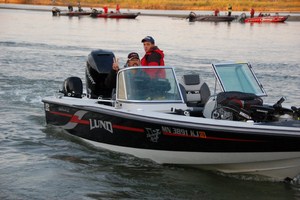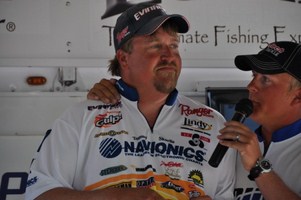Walleye First Tournament Series Walleye Tournament Future, Part 1
Category: article
Apr 27th, 2012 by OutdoorsFIRST
Modified Apr 27th, 2012 at 12:00 AM
Author’s Note: Over the next several months, a series of columns will explore the status of the walleye tournament world with a vision for the future. Many industry leaders, observers, participants (past and present), sponsors, professional and amateur anglers, host communities, marine and tackle manufacturers, and tournament organizers will offer their opinions.
Those who have been intimately familiar and inside the tournament game want the sport of competitive walleye fishing to continue, grow and attract new anglers and fans. Tournaments are real testing grounds. The lessons learned lead to new tactics, new gear, new boat designs, new fans, new customers, and most of all create better fishermen.
This begs three questions: What does the future hold? Specifically, how can tournaments adapt to the current economic climate? What will it take to grow tournament fields and popularity? These and more issues surrounding this topic will be addressed. This effort kicks off with observations from the godfather of walleye tournaments, media mogul and National Fresh Water Fishing Hall of Famer Ron Lindner. He is joined by National Professional Anglers Association executive director Pat Neu, who is also a walleye tournament pro and has spent his entire life in the fishing and hunting outdoor business.
 |
|
|
Pat Neu (WalleyeFIRST image)
|
Ron and Pat Speak:
“It’s a tough road,” Ron Lindner said of trying to make it in the sport of walleye fishing as a pro, “outside of Skarlis (as in Tommy, $63,000 winner at a recent FLW tournament), I don’t know who can make a living strictly from fishing. The Gofrons, Gilmans, Keenans and Parsons are in a different league with jobs that support them.”
Pat Neu echoed Ron and said, “The expenses involved with fishing a walleye circuit that involves extensive travel have increased drastically over the past 10 years. Increased expenses make it difficult for an angler to obtain a reasonable return on the investment of time and money.”
Pat, ever the analytical businessman, noted that lower payouts have meant lower angler turnout which leads to even lower payout, since anglers fish for their own money in most events. “Major pro-am expenses run $3,000 to $4,000 per event,” he said. “The combination of increased expenses and a soft economy have caused a high rate of attrition among walleye tournament anglers over the past four years. This reality will not change until the purses begin to grow at a pace commensurate with the costs.”
Always with an eye on all tournament markets, Ron chimed in and said, “It’s a tough road for walleye guys. It’s a much, much harder hump than the bass guys, and it could be three years until a few walleye pros can make it just from
 |
|
|
Caption Title (Credits)
|
fishing.”
|
|
Both men lamented the fact that reduced sponsor support for average anglers due to the economy has played a part. “There has to be a step-up from the tackle industry, but most of all, the walleye tournaments need a shot from non-industry sponsors – somebody has to do this – we need major sponsors like the National Guard in the FLW,” Ron emphasized. “And, I hope and pray FLW keeps the only walleye magazine going.”
The expense-issue continued to haunt their thinking. Pat said, “When gas was under $2 a gallon, food was $10 a day, lodging was $40 a night and boats cost $25,000, the game was more feasible. Without a change in payouts and sponsorship opportunities, the upper level walleye events will continue to face an uphill challenge.” Adding to what Pat said, with a nod to the current election cycle, Ron said, “Gas is a killer! I hope our nation has the ability to use wisdom to get people in control that can make a difference. This election will determine much about the walleye game into the future.”
Pat and Ron agreed a change in philosophy is needed. Interestingly, their opinions were similar, with Ron stretching the envelope yet again. Pat said, “It’s time for organizers to create a series of events that a person can fish with an average boat.” This would allow pro anglers to compete on a different scale, and open up the ranks to many more anglers, especially if the boats were 16 to 18 feet long with 100 to 150 horsepower outboards.
“This would bring the game to a larger potential group, which would also increase the fan base,” he said. Perhaps this would lead to a “Big Show” with a true qualifying system, he reflected. These events could be held on medium-sized waters. “The future must include a lower-cost alternative if we are going to see growth,” he said.
Ron felt that the MWC, Full Throttle and other similar team events might consider a higher level (more money) entry and payout. He added, “What about a series of Governor’s Cups?” The ideas kept flowing, and Ron said, “We need to join with Canada and create a bigger ‘plate’ in the entire walleye movement. The Canadians would make a real mark in tournaments if this could all be tied together.”
 |
|
|
|
“Walleye fishing is a 2-man sport,” Ron said, “And, as such must be developed with this unique character in mind. Teams reduce expenses. If top pro-level walleye fishing can’t make it, the sport may have to go to the next level, with maybe a few majors and a minor league feeder system from the team events. Don’t look to bass as the pattern for the future of walleye tournaments.”
Ron has watched the smaller team walleye tournaments, and noted that even in tough economic conditions they don’t lose teams and some are even growing. “Guys will fish; they may not travel as far or fish as many large events. That’s why the MWC is pulling good participation at many of their events and the Minnesota and Wisconsin statewide events are drawing OK numbers,” Ron said. He has noticed the big one-time events like the Merc National, Otter Street, Governor’s Cups and others are holding their own.
|
|
With the comparisons to bass fishing, Ron offered this “free” bit of advice, “Tackle-wise, walleye fishermen are more diverse than the bass crowd. The walleye guys must master more methodologies to be successful and had better be able to do it all. They are also much more dependent and more familiar with electronics than the bass world.”
Pat said, “My involvement with NPAA, past involvement with AIM and experience as a sponsored pro angler has given me a unique perspective. I love the competition and the sport of fishing. I want to see the sport exposed to future generations, because frankly, I believe many of the problems our country faces today are due to people losing touch with what really matters in life – families. Fishing brings families together!”
Pat and Ron have offered some interesting observations. Their opinions are meant to grow the sport while creating food for thought. Many other comments and ideas will be added throughout this series. Comments may be shared on the Walleye First Forum board.